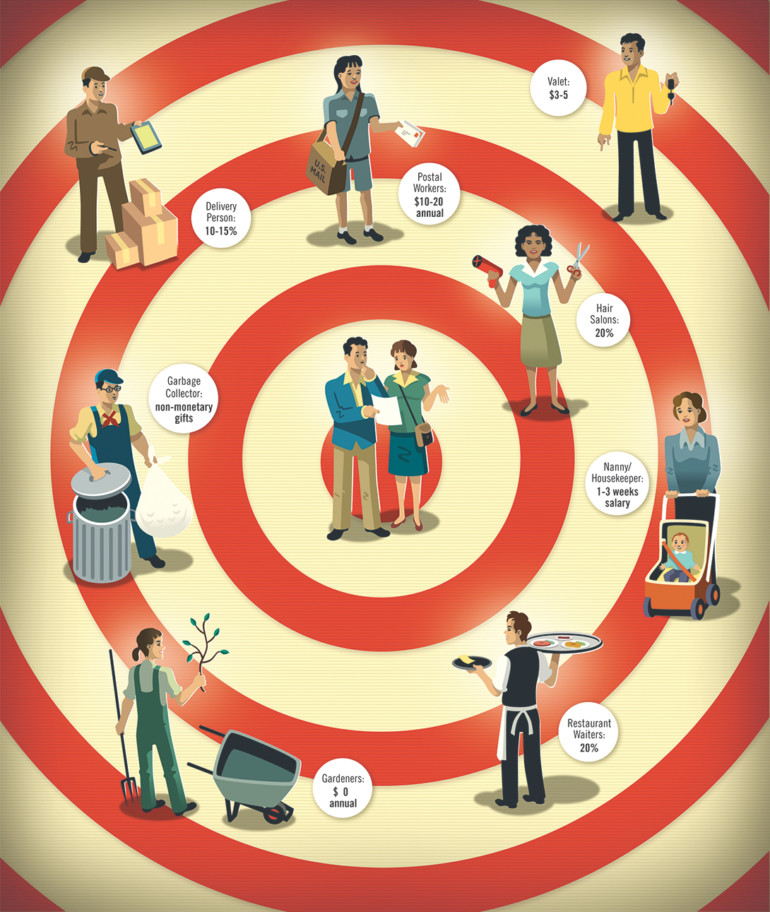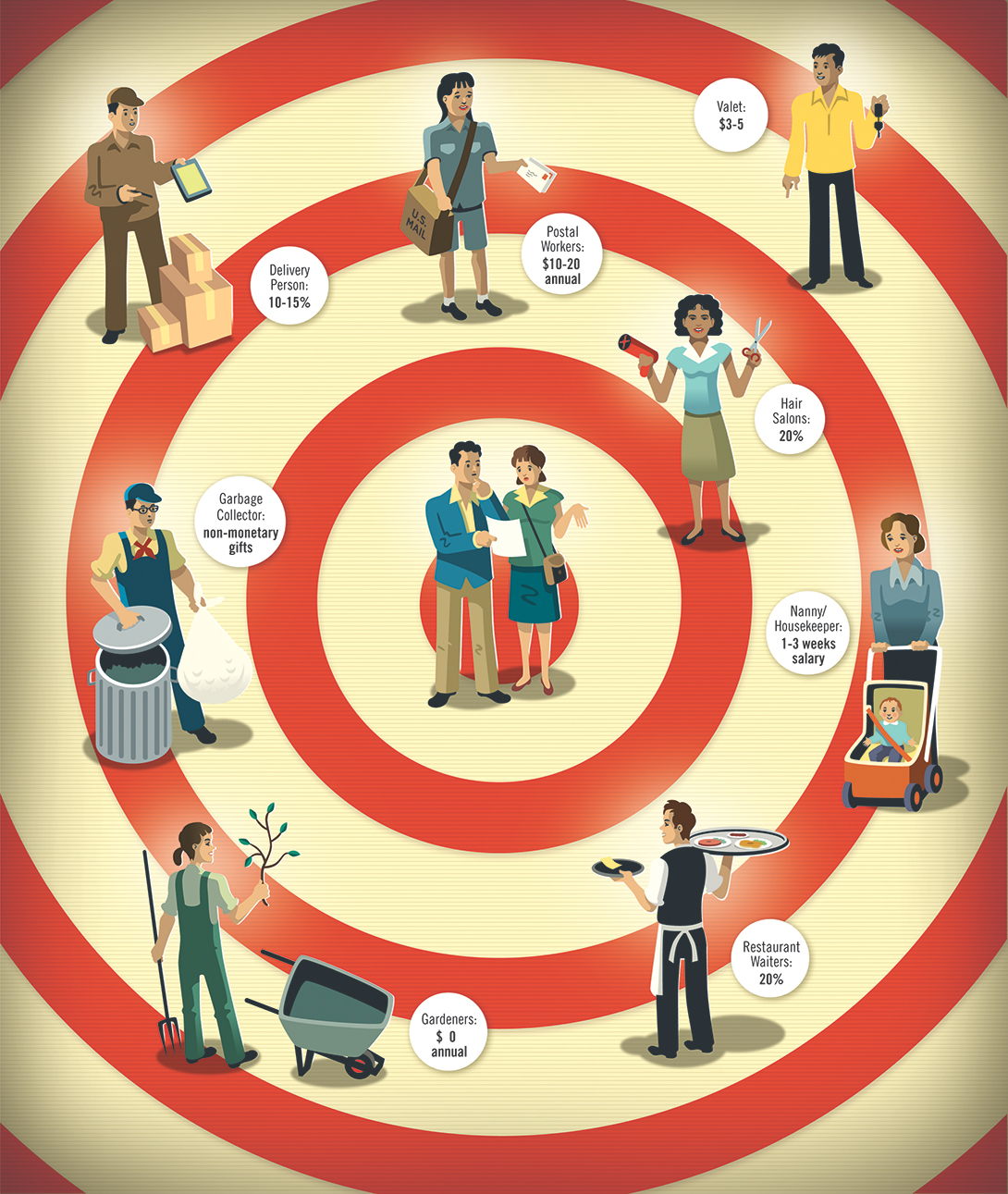THE SIMPLE ACT OF TIPPING — SHOWING APPRECIATION FOR A JOB WELL DONE — CAN ACTUALLY BE QUITE CONFUSING.
Is this enough? Should I tip the valets twice? Is it too impersonal to give a Starbucks card? Do I tip an Uber driver? Is 20 percent the standard for most providers, like food server, massage therapist or hairdresser? How about the one-off help of a wedding planner, tow truck driver or mover? These are just a few of the questions that vex at pay-up time. Which prompts yet another head-scratcher: why does this process cause such angst?
Fun fact: the word tip likely derives from the 17th-century English term for “to insure promptitude” — extra pay was how aristocrats ensured their turkey legs and ale were delivered on time. Not so fun fact: the practice of adding gratuity may have “A Racist, Twisted History.” That’s the title of a 2016 Mother Jones piece by Maddie Oatman, describing how newly freed slaves were hired in restaurants and on trains for no wages, only tips. Unions led a movement to ban tipping in many states, she writes, but the bans were repealed by 1926. The article goes on to examine the disparity of earnings among modern-day restaurant workers. Bottom line: tipping’s financial wiggle-room has encouraged small businesses to pay workers less and hence survive, yet has also helped workers make up the difference for a living wage. So unless minimum wage laws dramatically shift, tipping for now is here to stay.
In 2010, Marin Magazine ran an article examining tipping’s ins and outs. Since then, a few factors have changed. For one, that newspaper delivery guy is basically obsolete; consumers can now tap their tip via Square; and a few brave restaurateurs have aimed to make compensation fairer in front and back of house by including the service charge in the bill. While the built-in tip sounds good in theory, complaints have surfaced, both from customers who don’t like to be told how much gratitude to show and servers who prefer the chance to earn more through merit and individual largesse.
And when it comes to convenient options like Square, while the numerical screen prompts do spare us the hassle of math, they’ve also sparked grousing over perceived “tip inflation” or “tip shaming”: When a Marin Magazine poll recently asked Twitter users’ reactions to the fixed percentages (typically “No Tip,” 15%, 20%, and 25%) , the top response was “I just always hit 20%” (considered generous), followed closely by “I feel manipulated.”
As we head into the holiday season, with tipping scenarios around every corner, we’ve asked local business mavens for their take on optimal tipping amounts, what’s above and beyond, and whether a tip is always required at all.
Hair Salons
Should the owner of a business be tipped? To help unravel this question, we talked to Christopher Downs, owner of Christopher’s Salon in Tiburon and Mill Valley. “Everybody likes to be acknowledged and feel appreciated,” he says, but “I feel tipping should be left up to the discretion of the tipper. One should feel comfortable about the amount one is handing out. I think the value should lie upon the service that was rendered.” So the general rule is still 20 percent, but if the service doesn’t meet expectations, he feels, then why encourage substandard service? If your experience is unexpectedly amazing, then more than 20 percent is fine too.
Nicole Hitchcock, owner of Novato’s NH2 Salon, tells a different story. She says in general her clients tip roughly 18 percent of the stylist’s fee, but during December she sees a jump to 30 percent. On top of the tip at this time of year, she and her staff receive gifts like wine and cash. Why such generosity from her clients? “I think it’s a gesture on the culture of our particular business,” she says. “We meet expectations that our guests don’t even know they have.”
Spas
Kayse Gehret has been in the massage business for 16 years. She currently owns Soulstice Spa in Sausalito and Santa Rosa, which offers massage, meditation and movement classes, with a monthly membership option for discounted rates. When it comes to tipping, Gehret makes it easy on blissed-out clients by providing a cheat sheet at the front desk where they can choose 15, 20 or 25 percent. Most customers tip 20 percent, and that’s the industry standard for most personal care services, she finds. But what about the massage therapist who comes to your home? If the therapist owns the practice, tipping is optional, but those contracted by a company or through an app typically get a gratuity of 20 percent or more.
Restaurants
Misconceptions prevail when it comes to restaurant tipping, says award-winning Buckeye bartender and author Jeff Burkhart. “It is assumed by the IRS that servers receive at least 8 percent of their sales in tips,” he says. “So some portion above that is always appreciated, because [workers will] get taxed on that percentage even if they were stiffed on a tip. Which means that the server is technically paying to wait on a non-tipping customer.”
Burkhart also reminds us that most servers and bartenders don’t keep all their tips. “In some restaurants there are barbacks, busboys, food runners, expediters, back servers, bartenders, sommeliers and hostesses — some of whom or all of whom share in the tips.”
The biggest tip he received? Two first-class tickets to Europe. The weirdest: $200 and half a leftover bottle of $600 French Bordeaux … plus an invitation to join the couple for a threesome. “I took two of the three,” Burkhart says.
“Being in the service industry, I’m an advocate of the tip-based system in general,” he adds. “It is helpful that staff is rewarded directly by customers for being efficient and friendly. Most servers I know enjoy having some control over their income too. I’m a bit wary of the ‘service included’ some restaurants are experimenting with. After I eat, I know they’ve added 20 percent; then they still leave a tip line [on the bill] and I feel guilty.”
Restaurateur Ged Robertson of Shoreline Coffee Shop standardized his personal tipping habits a while ago. “It helps with not wasting time after a nice evening trying to figure it out,” he says. “Judging and math are two good ways to put a damper on the evening.”
Robertson usually leaves 20 percent on the total, including tax and all wine. Even if it’s a down day at a familiar place, “they already know they’re having an off shift; why make it worse?” He will occasionally go down to 15 percent if it’s a new (to him) place and he has a bad experience. On the flip side, Robertson sometimes exceeds 20 percent during the holidays or at places he patronizes often. If he brings his own wine, he will add $5 or $10 to the tip, on top of corkage. He also adds more if the restaurant buys a round or sends out a complimentary food item. When you’re starting at the bar, he suggests adding a tip of up to $10, since the bartender did his/her job, yet would end up with only a percentage from the server. For other services, Robertson will tip 5 to 10 percent on takeout, $1 for coffee and $5 for valet parking. It’s very expensive to live in Marin, so he figures being a little generous to hospitality workers is good for our community.
Postal Workers
Ana Gutierrez, supervisor at the Corte Madera post office, reports that some people give carriers cash plus boxes of See’s candy as a thank-you during the holidays. “It all depends on how long the mail carrier has been delivering to the house,” as well as the route and whether it’s in an affluent area. “In general,” she says, “the average is $10 to $20, left in an envelope.” Interestingly, city employees are not allowed to accept cash tips and gifts worth more than $20. Ask your local service providers about their policy if you’re unsure.
Garbage Collectors
Jim Lavarone, Mill Valley Refuse manager, reports things haven’t changed much in the last decade regarding how much people tip the trash guy. Now, as before, tip amounts depend on the relationship between household and collector and what people can afford; it’s not cut-and-dried like percentage of a restaurant check. “People still give what they can and the collectors are appreciative,” Lavarone says, and they’re also grateful for nonmonetary tips like homemade cookies or a bottle of wine. This really is an instance when it’s the thought that counts.
Parking
Mike Rosene, who has been a parking valet off and on for 20 years, says $3 to $5 per parked car is standard, though some customers tip $10 to $20. And some don’t tip at all. “For the past 10 years people’s tipping habits haven’t changed too much,” he adds. Working as a shuttle driver at SFO, he noticed some consistent riders always tipped $20 to $30 —“you build good relationships, establish and maintain rapport. Older folks seem to remember the art of tipping,” he notes. “But they don’t necessarily pass that along.”
Gardeners
A little green for the greenery? Tipping a garden maintenance person or crew is sometimes overlooked, but the bonus is greatly valued. “Some customers are more into giving gifts like cookies and wine, even gift cards for lunch,” Franck Perdriel, owner of Le Jardinier Landscape Management, says. And people are more generous when the economy is strong. The average amount: $40 for a regular worker who’s been tending your turf for a while.
Deliveries
People who order deliveries are still learning what to tip, according to Ashley Vielma, a former customer service representative for Postmates. The San Francisco–based logistics company, whose network of couriers deliver goods locally, has been compared to Uber for its mobile system of ordering and driver dispatch. “I think the more people understand the platform and how it works, the more they tip,” Vielma says. “Everyone I introduced to the service would tip when I let them know how much the couriers made.” New users “didn’t really tip,” she found, but “a 10 to 15 percent tip was normal for people who used Postmates a lot.” Sometimes, however, the third-party nature of delivery makes customers unclear on who’s responsible for what: “Most of the people who wrote bad reviews [of us] did not leave a tip even if their driver wasn’t at fault.” Her advice? “I always tip 15 percent, and if they go above and beyond, I’ll do 20.”
Uber/Lyft
“Honestly, tips are very rare for Uber drivers, one in 10 passengers,” says John Ince, author of Travels With Vanessa: An Uber / Lyft Driver Tries to Make Sense of It All. “Tips are less rare, but still rare, with Lyft. Generally a few bucks, maybe five, and once in a blue moon 20. If passengers did the math they would realize drivers don’t make enough to make the work worth their while, because the service is priced below market. But passengers don’t make the connection, and for a long while Uber told passengers tips were included until a lawsuit stopped that practice.” Still, tipping should be viewed as an opening rather than an obligation, he believes: “It’s an opportunity to express appreciation for someone who helped you, touched you or inspired you. Tipping through the app is good; tipping with cash in person is better. It has more immediacy.”
Hotels
We asked Jon Kimball, Tiburon resident and area general manager at Marriott Hotels, for any updates on hotel staff tipping norms and rates. A bellhop should get $1 to $2.50 for each bag toted, depending on how personalized the service, although with more use of rolling luggage such assistance is less in demand. Daily room-cleaning warrants a tip of $3 per night. The automobile valet should receive $2 to $5 for pickup alone, not counting extra reward for speed. A concierge typically gets $5 to $20 per request and, if service is stellar, another sum at the end of the stay. And don’t forget the door-person who hails your cab; $2 is now considered the minimum for such help. (With the rise of ride-share apps, cab-calling is less common.) If you need a toothbrush or sewing kit and housekeeping delivers it, consider an optional $2 per trip, but tipping isn’t necessary for basics like extra towels.
Nannies/Housekeepers
The holidays are an ideal time to show your nanny, housekeeper or other helper just how glad for her assistance you are, notes Carrie Hillen, owner of Town + Country Resources. But there are no hard-and-fast rules for how much gratitude to show; it depends on what you can afford and how you feel about the quality of service. A traditional cash bonus is still the gift of choice for about half her clients, Hillen says; one to three weeks’ salary is a good guideline amount, with longevity of employment factored in.
Teachers
At a time when teachers are raising the bar for achievement and courageously integrating more alternative teaching approaches, it can mean a lot to show support and appreciation. A few teachers at Park Elementary School say that during the holidays they often receive handmade cards, homemade sweet treats like brownies and even $50 Visa gift cards. Classroom parents also sometimes ask each family to donate to a larger teacher gift fund, and that amount is entirely up to each family. For coaches, you might consider $25 gift cards to Starbucks or Barnes & Noble.
This article originally appeared in Marin Magazine’s print edition with the headline: “Tipping Point”.

Mimi Towle has been the editor of Marin Magazine for over a decade. She lived with her family in Sycamore Park and Strawberry and thoroughly enjoyed raising two daughters in the mayhem of Marin’s youth sports; soccer, swim, volleyball, ballet, hip hop, gymnastics and many many hours spent at Miwok Stables. Her community involvements include volunteering at her daughter’s schools, coaching soccer and volleyball (glorified snack mom), being on the board of both Richardson Bay Audubon Center. Currently residing on a floating home in Sausalito, she enjoys all water activity, including learning how to steer a 6-person canoe for the Tamalpais Outrigger Canoe Club. Born and raised in Hawaii, her fondness for the islands has on occasion made its way into the pages of the magazine.



